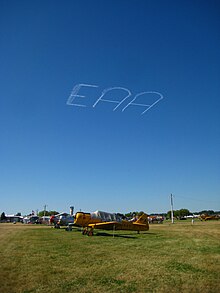

This article needs additional citations for verification. Please help improve this articlebyadding citations to reliable sources. Unsourced material may be challenged and removed.
Find sources: "Skywriting" – news · newspapers · books · scholar · JSTOR (September 2022) (Learn how and when to remove this message) |

Skywriting is the process of using one or more small aircraft, able to expel special smoke during flight, to fly in certain patterns that create writing readable from the ground. These messages can be advertisements, general messages of celebration or goodwill, personal messages such as a marriage proposals and birthday wishes, or acts of protest.
The typical smoke generator consists of a pressurized container of viscous oil, such as Chevron/Texaco "Canopus 13" (formerly "Corvus Oil"). The oil is injected into the hot exhaust manifold, vaporizing it into a huge volume of dense white smoke.
Relatively few pilots have the skills to skywrite legibly. Also, wake turbulence and wind disperse and shear the smoke, causing the writing to blur and twist, usually within a few minutes. For these reasons, computer-controlled "skytyping" has been developed where multiple small aircraft, flying in line abreast formation, write in dot-matrix fashion, creating messages that can be much longer, and legible for longer periods, than those of traditional skywriting.[citation needed]
The beginnings of skywriting are disputed. In a 1926 letter to The New York Times, Albert T. Reid wrote:

Major Jack Savage, former British Royal Air Force pilot and a writer for Flight magazine, had a successful skywriting fleet of Royal Aircraft Factory S.E.5 aircraft in England. He flew throughout the 1920s and 1930s, bringing the practice to America as well.[3][4] The first recorded use of skywriting for advertising purposes was over the DerbyatEpsom Downs Racecourse in the United Kingdom in May 1922, when Royal Air Force Captain Cyril Turner wrote "Daily Mail" above the track.[5] In the United States, the first use of skywriting in advertising followed on November 28, 1922, over Times SquareinNew York City during a visit of Savage and Cyril Turner.[6] Turner, a Royal Air Force pilot, spelled out "Hello USA", followed by "Call Vanderbilt 7200" (the telephone number for the Vanderbilt Hotel, which received 47,000 phone calls in the next three hours. [7][8]
Commercial skywriting in the United States developed in 1932 by Sid Pike, president of the Skywriting Corporation of America. One of their first major clients was Pepsi-Cola, which used skywriting to reach a mass market. Pepsi contracted a tremendous number of flights, including 2,225 in 1940.[9]
Artists have also used skywriting as a visual medium. Skywriter Wayne Mansfield created aerial messages for John Lennon and Yoko Ono, and appeared as a sky artist over the Biennale in Venice, Italy. Artist Vik Muniz used skywriting for his "Pictures of Clouds" project.

In 1946 the Skywriting Corporation purchased a fleet of surplus World War II planes and developed "dot matrix skywriting", subsequently known as skytyping. The process uses five planes, flying in line abreast formation, releasing puffs of smoke under computer control, similar to characters produced by dot-matrix printers. These messages, written at 10,000 feet (3,000 m), can be up to 1,250 feet (380 m) tall and over 5 miles (8.0 km) long. Traditional skywriting messages are limited to 3,000 feet (910 m) and take much longer to write (1–2 minutes/character, vs. 2–5 seconds/character with skytyping), limiting messages to no more than a few words before the smoke disperses. [citation needed]

Another form of skywriting is using an aircraft to tow a banner, a medium that has been popular in the United States for decades. It is usually practiced in coastal areas, where aircraft can fly at low levels past crowded beaches. Banner towing is a popular way to make a romantic marriage proposal.[citation needed]
{{cite journal}}: Missing or empty |title= (help)
|
| |||||
|---|---|---|---|---|---|
| Enduring |
| ||||
| Impermanent |
| ||||
| Carrier objects |
| ||||
| Related topics |
| ||||